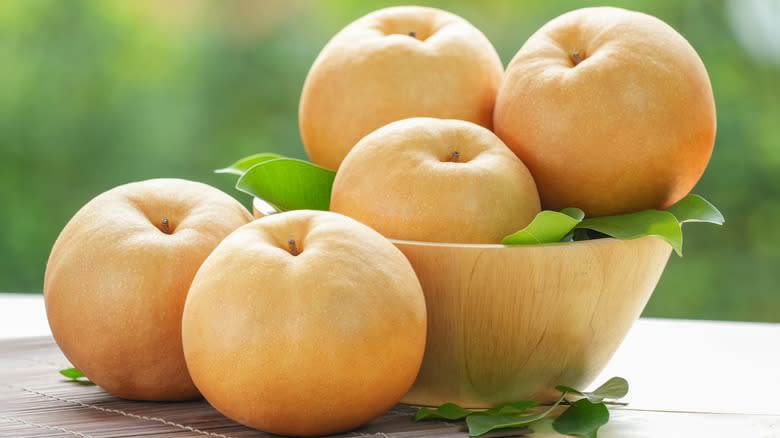The Reason Asian Pears Don't Work Well In Baking Recipes

In the realm of pear varieties, the Asian pear is an odd entry in the family. This type of fruit looks more like an apple than anything else. It's also golden in color, ripens on a tree, and has a crunchy texture and juicy bite. However, the taste calls to mind the mildly sweet, just barely tart flavor of a pear as well as its slight graininess. With all of these unusual yet tasty characteristics, you may think this fruit is perfect for baking. Unfortunately, that's not the case.
While the Asian pear has a refreshing taste and texture, it has a very high moisture content, meaning it packs a lot of liquid. When you bake this fruit, a river of water will be released, which will turn whatever pastry crust or cake batter you've baked into a mushy mess. In fact, the Asian pear is so saturated that it's rarely used to make jams or jellies either. Thankfully, there are still a multitude of different things you can do with this type of fruit.
Read more: 19 Tropical Fruits, Ranked Worst To Best
The Juiciest Fruit Around

Simply put, Asian pears are best enjoyed as a piece of fresh produce, as the Koreans and Japanese have been eating it for years. But there are a few options if you'd like to work it into your dinner plans. You can use it raw, sliced, and chopped, in an Asian-inspired coleslaw or grain salad. These bits of fruit will add refreshing sweetness and a snappy texture to the mix. You could also pickle some of the slices, much like you could make pickled carrots or onions to add a bit of zippy contrast. Some recipes will even incorporate Asian pear into their marinades and sauces to add a subtle sweetness.
As for baking, it's best to stick with firmer, less juicy pear varieties like Anjou or Bartlett pears. These varieties hold their shape and will release less liquid, so you can avoid soggy-bottomed tarts or wet cakes. But if you're still insistent on having the Asian pear as part of your dessert, try cutting it up and adding small slices to a bowl of ice cream or turn it into a sorbet. This way you won't create a mushy mess with your baked goods and you'll still be able to savor the fruit's sweet and tart flavor.
Read the original article on Tasting Table.

